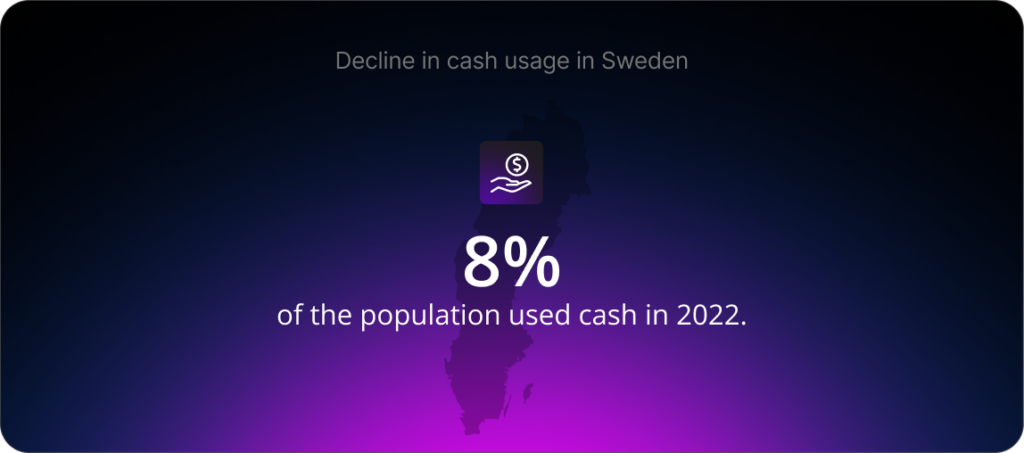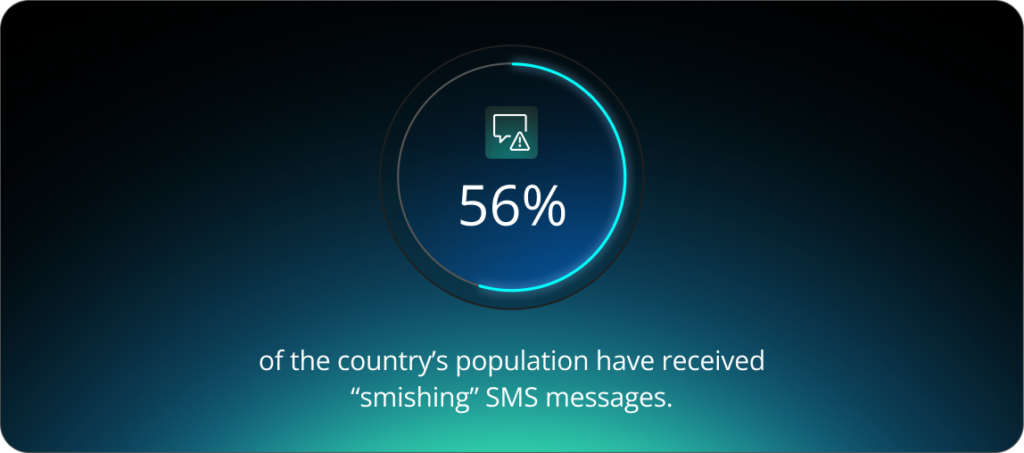Back in 1661, Sweden made history by issuing Europe’s first paper banknotes. Today, the country is once again leading a financial revolution — this time by nearly eliminating cash altogether. According to the Swedish central bank, only 8% of the population used cash in 2022, and the amount of physical currency in circulation has dropped by half since 2007.
With digital wallets, instant mobile transfers, and biometric identification, daily transactions in Sweden have become almost entirely virtual. But this rapid shift raises new concerns — from digital fraud to financial exclusion — prompting officials to ask a pressing question: how do you build a cashless society that works for everyone?
As of December 2024, Sweden’s financial system – which includes banks, mutual and pension funds, insurance companies, housing credit institutions and FinTechs, among others – had assets totaling SEK 8 trillion, equivalent to about 12 times gross domestic product, central bank data shows. The country’s biggest banks based on total assets include SEB, Handelsbanken, and Swedbank. The FinTech landscape is also flourishing, led by key players including buy now, pay later giant Klarna, open-banking platform Tink, which connects more than 3,400 banks in 18 countries, and digital payment provider Trustly.
From debit and credit cards to the BankID system, special investment accounts including Investeringssparkonto and basic savings through Sparkonto, and mobile payment apps such as Swish – used by more than 80% of the population – Sweden is set to become the world’s first cashless society. However, challenges persist, including rising fraud, financial exclusion, and a dependency on private banking infrastructure. This has raised concerns over the future of money in Sweden, with the Sveriges Riksbank facing the task of ensuring a secure and inclusive financial system while steering the nation’s cashless payment system.
“The Swedish payments market has been digitalized at a rapid pace,” Sveriges Riksbank says in its 2024 Payments Report. “Developments suggest that we should focus more than previously on the challenges posed by digitalization. This concerns both the resilience of the payment system in the event of disruptions, crises and wars, and the ability of everyone in society to pay,” it adds.
In our Banking is Local series, we put Sweden’s cashless economy in the spotlight amid concerns over a surge in digital financial fraud and financial exclusion.

What is driving Sweden’s cashless society?
The country’s rapid digitalization of payments has been driven by several factors:
- A supportive regulatory framework encouraging innovation
- Tech-savvy citizens who quickly adopted mobile banking
- A strong and trusted banking sector
However, it was a spate of robberies in the 1990s that set the country on its cashless path. In 2012, a consortium of banks launched Swish, which allows real-time account-to-account transfers and relies on BankID, Sweden’s electronic identification system. Introduced in 2001, BankID is used by adults more than twice a day on average for everything from managing their tax returns to paying for bus tickets.
Widespread internet and mobile coverage have further encouraged businesses to phase out cash, supported by the country’s legal landscape under Swedish contract law, which allows merchants to refuse cash payments if they display a “No Cash Accepted” sign on their premises. The pandemic also boosted the country’s reliance on digital payments, as using physical notes was seen as a potential health risk.
How a cashless economy shapes daily life in Sweden?
Sweden leads the Nordic countries—and all other nations worldwide—in its efforts to become a cashless economy. But countries such as Finland and Norway also aim to have their economies dominated by digital payments. In Finland, for instance, just 6% of the population prefer to pay for their daily goods with cash, while in Norway, only 3% use cash to shop.
For most Swedes, daily life runs smoothly without cash, as supermarkets, cafes, and even outdoor market vendors widely accept Swish or debit and credit cards. This speeds up queues and waiting times and reduces the hassle of handling cash, while digital invoicing has simplified the payment of monthly bills. The Swish app also allows them to make instant payments to friends.
Mobile banking apps offer digital budgeting features that allow customers to track their spending in real time, while BankID allows citizens to access health care, sign rental contracts, and pay their taxes, among other features. However, some worry that financial literacy is suffering, and tracking spending digitally could lead to overspending and debt, particularly for younger consumers.
The rise of fraud and financial exclusion
Other issues have also emerged, with financial fraud surging to become the fastest type of crime in Sweden, according to a report by Sveriges Riksbank. Bank card fraud jumped 44% between 2022 and 2023, while social engineering fraud by telephone is also on the rise, and the victims are most likely to be elderly.
According to a survey by the Swedish Bankers’ Association, more than half of the country’s population have received “smishing” SMS messages, while one in 10 people had followed the prompts in the text message before realizing that it was a fraud attempt. Meanwhile, financial inclusion has become a priority for Sveriges Riksbank, which says that more private citizens, companies, and associations must be offered the possibility of having digital payment accounts.

It also emphasizes that banks and other payment service providers must adapt their cashless payment systems for people who have difficulty using digital services. This includes offering customers affordable over-the-counter payments, paying by postal giro or making greater use of technological innovations such as biometrics for payments and identification, the central bank says.
How the Riksbank protects cash and prepares for the E-Krona
One issue the country faces as it implements its cashless payment system is that, ironically, there is no cash for emergencies. The realization led to the Severiges Riksbank Act, which came into force in January 2023, and gives the central bank clearer and partly expanded responsibility for Sweden’s cash infrastructure, which includes operating at least five banknote depots across the country. However, it argues that more measures are needed to ensure that cash remains an option for essential goods in times of emergency.
In a letter to the Ministry of Finance in October 2023, Sveriges Riksbank said legislation on cash needed to be tightened immediately to prevent people suffering digital and financial exclusion. It also noted that cash was important for Sweden’s preparedness, particularly if electricity and telecommunications were eliminated.
Meanwhile, to offset the dependence on private banks, Sveriges Riksbank is also exploring the introduction of a Central Bank Digital Currency (CBDC) called the E-Krona. This would help boost financial inclusion, enhance cross-border transactions and foster stronger payment security.
There is also a move to reduce the country’s heavy reliance on Swish as a single platform. While uptake remains limited, the central bank has introduced RIX-INST, which uses the same technical platform as TIPS, the European instant payment system.
The future of cash in Sweden and Europe
Sweden’s journey offers a glimpse into what a nearly cashless future might look like — sleek, fast, and efficient, but not without pitfalls. The key takeaway? Innovation must be balanced with inclusion, resilience, and security.
As countries around the world explore their own digital transformations, Sweden’s experience serves as both inspiration and a warning: going cashless is possible, but leaving no one behind is the real challenge.
For more expert content on industry outlooks and innovation, subscribe to our newsletter or visit our Insights page.
This article is also available in video format—watch below.
Questions & Answers
What is BankID and how is it used in Sweden? + –
BankID is Sweden’s national digital identity system, used by nearly all adults to securely access banking, government, and everyday digital services. Operated by a consortium of banks, it enables users to verify their identity, sign documents, and authorize payments through biometric or code-based authentication.
What is Swish and why is it popular in Sweden? + –
Swish is Sweden’s leading mobile payment app, launched in 2012 by major banks. It enables instant money transfers using a phone number and BankID for secure verification.
What is the E-Krona? + –
The E-Krona is the Riksbank’s proposed digital currency aimed at complementing cash.
Is it legal to not accept cash in Sweden? + –
Yes, under Swedish contract law, businesses are allowed to refuse cash payments as long as they clearly display a “No Cash Accepted” sign. This rule has helped accelerate Sweden’s shift toward digital and mobile payments.